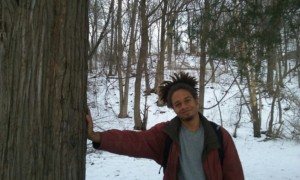Contact Spinning a Fire Staff

Simeon Spottwsood
Simeon is a sophomore at SUNY-ESF with a major in Forest Resources Management. He is also the President of the Seed Bank, a new club on campus that works to implement positive change by raising awareness about important issues, creating student run projects, and having students engage in community service. He is an avid participant in recreation activities such as slacklining, skateboarding, and rock climbing.
People may think of contact spinning as a performer spinning an object with their hands but technically this is misleading. One of the goals of contact spinning a staff is to manipulate the object around one’s self while at any given point maximizing the contact with the body. This movement includes the hands, but also includes shoulders, wrists, elbows, neck, armpits and really any other part of the body covered in skin. One might even say that the object of contact spinning is to minimize the grasping of the staff with the hands in order to explore the other possibilities of movement. Spinning a staff should be like unfurling a flag, the movements should look like they tumble out of the performer with as little resistance as possible so as not to break the rhythm of the spinning object.
Upon receiving an assignment for a writing course wherein we had to observe a field site, I decided to focus on the site of my contact spinning staff in interaction with my body. I could not pretend that I did not affect what happened at my site since I was an integral part of it. I came to identify a phenomenon that I call ‘the golden moment” encapsulated in a haiku I wrote on my site:
Movement
Spinning weight takes tour
round rolling mountains of flesh
does it really go?
While spinning the contact staff, there are different modes of consciousness that I inhabit. In the basic mode, I am the reference point; the staff rotates about myself. But I find that in the truly captivating moments, I am moving with the staff. The staff and I start spinning in equilibrium and our bodies begin to possess the same momentum. When I enter that golden moment, there are two aspects of the staff’s movement: one directed by intention or executed response and the other directed by conditioned reaction. When these two kinds of movement are balanced and linked like a chain, they create the golden moment. However, even this is only an explanatory tool—to say that there are only two ways is an overgeneralization—there are many other variables involved in the movement of a staff such as, “angle of release, release velocity, location of throws, [and] height of throws” (Beek 92-97). These linking aspects are consistent between what is normally thought of as juggling and object manipulations like contact staff, flower sticks, and Chinese yo-yo.
All of these object manipulations require an executed response—what happens when one is intending to do something and is thinking about doing it, while doing it. As directed attention, it is something that must be consciously thought about. It would not be true to say that there is no thought involved in a conditioned reaction but rather more so that a conditioned reaction happens on a subconscious level of thought. All executed responses may become conditioned reactions as long as there is enough experience for the thought involved to become subconscious. Conditioned reactions still require intention but mostly only to begin their movements. They are reactions to familiar stimuli, not a response to the unknown. The conditioned reaction occurs once a movement is started and the object seems to fall into a pattern seemingly of its own accord. It is not really thought about on the level of the mind we correlate with the physical head; the thinking suggests a type of cellular intelligence, where memory is ingrained into the very muscle fibers and ligaments.
Balancing these conditioned reactions and executed responses makes an effective performance. My division of concepts is similar to a popular distinction in the juggling community, except the terms used are tech and flow. Tech is about discovering what is possible—the exploration of the unknown. Flow is all about transitions (Goblin Juggler). There are two basic modes of juggling ball performances, one in which the juggler does a pattern, stops and does another—this is the tech perspective. On the flow side, almost no interruptions occur and the focus is upon connecting moves together with smooth transitions. The perspective of flow performance is more necessary when wielding something like a contact staff; it is all about keeping the momentum going forward as fluidly as possible. Executed responses are more akin to tech, while conditioned reactions associate more closely with flow. Although tech and flow are not inherently the same as conditioned reactions and executed responses, they refer to similar aspects of what can be viewed as a singular process. Juggling does not always involve juggling multiple objects, but it always involves juggling your attention.
One of the keys to juggling therefore involves a balanced shifting of attention. When one is present in the golden moment of awareness, there is a flow from the familiarity of a conditioned reaction to an executed response to another conditioned reaction. If this pattern is unbroken so is the momentum of the staff.

Shifting between executed responses and conditioned reactions is an automatism–the performance of actions without conscious thought or intention. The automatism is initiated by an executed response and is established by connecting knowledge-conditioned reactions. Automatisms allow one to spend less attention on the particular single throws, and instead focus on more complex structures, i.e. patterns, and the process of switching between them. (Bovermann 1). Even when individual moves become automatisms, these still need to be linked. You want to work a grove until it’s hard not to slip into it. One of the key goals of juggling is to make things appear as if they happen of their own accord, seemingly without strain or effort. This lack of strain is created by not putting too much emphasis on either motion or stillness. For this effortlessness the juggler needs to be in a state of metastability, which is a kind of balance:
Although stable instability may seem like an oxymoron, individuals are often in a state of flux, which allows them to transfer smoothly from relatively stable to relatively unstable conditions (change from stance to flight phase during running). Without some degree of instability, it would be impossible to move; however, without some degree of stability, it would be impossible to maintain equilibrium or to remain upright. Hence, a degree of stable instability or relative instability is aptly described by the term “metastability.” (Kibele 2)
Metastability is shifting well through different points of equilibrium. I found such shifting to be fundamental to the interactions at my site. This is what the flow perspective of juggling is all about. It is non-resistance; the ability to allow movements to blend into each other so that they appear to be one movement. After an array of automatisms have been formed, they link to create seamless transitions; this is what makes motions appear as if they were cascading or flowing into each other like water.
When I enter the golden moment, I question things like who or what is moving? Is it I that is spinning or the staff? In the basic mode, you think you are the wielder of the staff. However, as you enter more deeply into the golden moment you lose track of the staff as a separate thing. It becomes melded with yourself, embodying and expressing your energy. Upon entering that mode of expression not only do I realize that I am not wielding the staff, I also become aware that the staff and I are one instrument being wielded by the creative force of a larger inspiration. The moment I am able to stop asserting that I am the one who is doing, the most fantastic array of rotations begin to cascade like improvisational jazz, where the player does not plan what they are playing, but is simply led to play.
